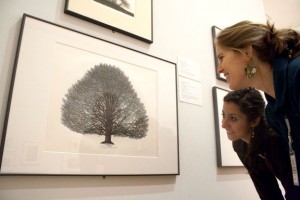From a 15th-century woodcut depicting the scene of the Fall of Man with vine-covered, leafy trees to a print of a tree farm in China littered with plastic bags, the latest exhibit at the Herbert F. Johnson Museum of Art at Cornell University looks at trees from all angles.

“Trees and Other Ramifications: Branches in Nature and Culture” at the Johnson Museum is predominantly a collection of prints, drawings, books and photographs meant to offer an open-ended look at some of the ways trees have been meaningful to humanity and the continued importance of the natural world. It includes a variety of pieces — from 15th-century etchings to modern prints and photographs. The works explore a number of themes including evolution, family lineage, environmental awareness and humans’ relation to nature.
Between the varieties of media, the exhibition offers an interesting and thought-provoking look at humanity, nature and its importance. The fact that the pieces explore such a range of themes on one subject gives the collection its strength.
Stepping into the exhibit, the visitor is immediately drawn to a compilation photograph, “Structure of Thought 15,” by Mike and Doug Starn. The piece shows an ailing Camperdown Elm in New York City that is dying from Dutch elm disease. Its thick branches are shown in black with a gloomy green sky. The piece is a striking introduction to the rest of the collection. Covering almost an entire wall, it gives the viewer a first look at the impressive beauty of trees as well as one of the themes in the rest of the show — the issues facing the natural world.
Other pieces in the collection show some of the current problems in the environment. Most notably, the prints by Pok Chi Lau explore some of the destruction humanity has inflicted on nature. In the black and white print “Lone Lychee Tree, Shenzhen, China,” one tree sits atop a mound of dirt in the middle of a pond next to a city development. The tree was the only survivor in an excavated lychee orchard. The long expanse of blank color in the water surrounding the tree helps to subtly emphasize its loneliness.
In contrast, a print by Klaus Staeck called “A New Life Blossoms from the Ruins” explores the resilience of nature and its ability to reclaim an area once it is abandoned by humanity. The print shows gray highway roads overlapping and linking together, while a bright green tree grows up through them. Shown together, these pieces are also examples of how the exhibit as a whole looks at a range of themes — sometimes even contradictory ones — but this only works to make it more interesting.
The organization and physical display of the pieces likewise help to reveal the collection’s themes. On one wall, a print of the branching and twisting retinal arteries and veins in a person’s eye by Harold Eugene Edgerton called “White of the Eye” is shown just above a close-up image of an orchard. The photograph shows long, black lines in the eye linking together in a similar way the digital print by Tanaka Ryohei “Trees #3” below shows the branches of peach, cherry or plum trees growing and bending. Theses pieces displayed side by side help to show the relation humans have to the natural world.
“Trees and Other Ramifications” gives its viewers an all-inclusive look at trees through time. It gives a glimpse of them as aesthetic wonders, points of biological study and pieces of inspiration. Because it offers such a wide range of topics, it beautifully confronts viewers with the importance of a subject most people pass by each day.
“Trees and Other Ramifications: Branches in Nature and Culture” will show at the Herbert F. Johnson Museum of Art now until Jan. 2. It was organized by Stephen Goddard, senior curator of prints and drawings at the Spencer Museum of Art at the University of Kansas.




